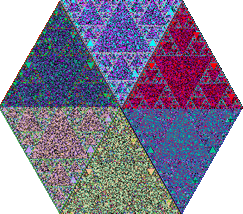Three's a Pair! - Melodic Minor ii-V7-i Triad Pairs

One of the earlier examples of the use of triad pairs can be found in the well known 1959 recorded TV version of John Coltrane's solo on Miles Davis' "So What", when he was still a member of the trumpeter's quintet.
Coltrane can be heard to clearly enunciate both G and F Maj. triads (built from the 5th and 4th scale degrees, respectively, of the C Major scale) in sequence over a basic D-7 for most of the first 10 bars of his second chorus, beginning at 4:51 of the above linked YouTube video.
There are many subsequent examples of the use of these, and other, triad pairs to be found in 'Trane's solos on numerous versions of his own compositional adaptation of the "So What" changes; namely, "Impressions".
Likewise, the same G and F Maj. triad pair is in evidence on Coltrane's 1962 trio recording of his original, "Big Nick" (solo transcription here).
I eventually got hip to the concept from the following books, authored by three different tenor saxophone masters:
- Walt Weiskfopf - "Intervalic Improvisation - The Modern Sound: A Step Beyond Linear Improvisation" (J. Aebersold - 1995)
- Gary Campbell - "Triad Pairs for Jazz" (Warner Bros. - 2001)
- Jerry Bergonzi - "Inside Improvisation Series Vol. 7 - Hexatonics" (Advance Music - 2006)
Any one of these great books will set you straight on the concept of using triad pairs as an improvisational device.
Since I personally like the sound of Melodic Minor (oh, so you've noticed!), I took to getting its definitive triad pairs hammered into my subconscious.
Getting back to the 1959 Coltrane example for a moment; 2 Major triads (F & G) were built a whole step apart, on the fourth and fifth steps of the C Major Scale (F-A-C and G-B-D). This 6 note grouping can be either lydian or mixolydian in nature, and it forms the hexatonic scale F-G-A-B-C-D, as well as a G 11 chord (G-B-D-F-A-C).
To get the sound of Melodic Minor, in our case, we use one Major and one Augmented triad a whole step apart, also built on the 4th and 5th scale steps.
In C Melodic Minor, for example, that would be F Maj (F-A-C) and G Augmented (G-B-Eb) triads. The resulting hexatonic scale is then Eb-F-G-A-B-C, which forms an F7#11 when stretched out as a chord in thirds.
The slick part of using this Melodic Minor triad pair as a V7 chord, as is used in the below ii-V7-i example, is that the F7#11 becomes its tritone sub; namely a B7b5b9b13 (B-D#-F-A-C-G), better known as B7alt (V7 chord, resolving to E min.).
Notice that this 6 note configuration is one note (D) short of a B altered scale, the 7th mode of C Melodic Minor.
As a ii chord (to the key of G, Maj or min), this same triad pair would read as A-C-Eb-G-B-F (A-7b5 9 b13).
The note "F" (or b13), in this case, might seem a bit ambiguous at first, but 1) the ear hears it as part of the F Maj half of the triad pair and 2) Melodic Minor has no avoid notes, hah hah! Remember?
Any rules that apply to Melodic Minor, apply to its triad pairs as well.
Ok, so on to the bid-niz at hand.
The Line 1 breakdown (G-7b5 / C7alt / F- / F- ) of the PDF download reads:
Measure 1, Line 1 = ii7b5 = G-7b5 = Bb Melodic Minor = Eb Maj & F Aug = Eb-F-G-A-Bb-Db
Measure 2, Line 1 = V7alt = C7alt = C# Melodic Minor = F# Maj & G# Aug (also G# Maj) = F#-G#-A#-C-C#-(D#)-E
Measures 3 & 4, Line 1 = i = F min = F Melodic Minor = Bb Maj & C Aug (also F min) = Bb-C-D-E-F-Ab
When using triad pairs, the order in which the triads are expressed is irrelevant.
It ain't rocket science, but it is kinda scientific!
Don't let the triplets trip you up! Start out at a manageable tempo.
Play it in the range that is most comfortable for you and your instrument.

 RSS Feed
RSS Feed









